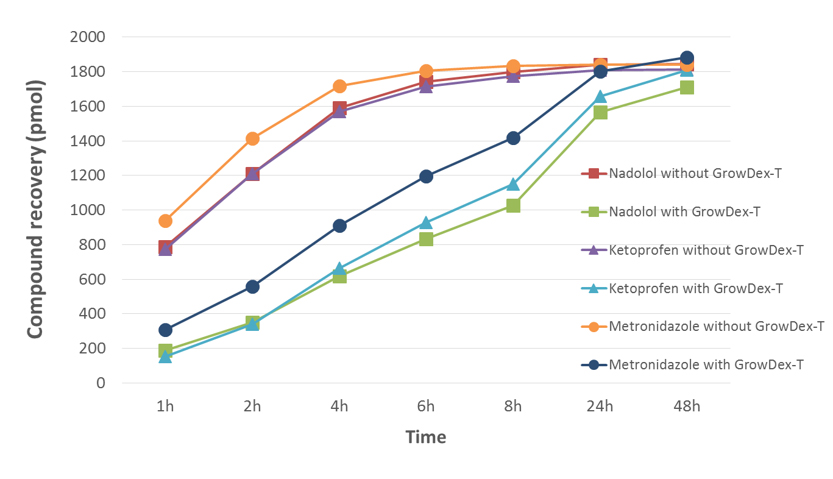Lauri Paasonen (Ph.D.), UPM, Finland & Sanna-Mari Aatsinki (Ph.D.), Admescope, Finland
INTRODUCTION
Diffusion of various molecules, such as nutrients and oxygen, in a 3D cell culture matrix is crucial for sustained viability and functionality of the cells. In cell-based drug efficacy screening and toxicity evaluation assays, it is essential that the drug/compound under test is able to reach the cells in the hydrogel layer easily. Typical set up for a 3D cell-based assay involves the drug/compound to be administered either on top of or below the cell-containing hydrogel layer. The compound will then be left to diffuse through the culture matrix. Physicochemical properties such as molecular weight, charge and lipophilicity of the drug molecules may affect the rate of diffusion.
GrowDex-T is transparent, anionic nanofibrillar cellulose hydrogel for 3D cell culture. GrowDex-T supports 3D growth of various cell types, which indicates that adequate diffusion of nutrients and gases within the hydrogel has occurred. It has also been demonstrated that native GrowDex allows the permeation of small drug molecules (Application note #20).
In this study diffusion rates of small drug molecules, namely nadolol, ketoprofen and metronidazole, through GrowDex-T were evaluated. Test drugs were administered on top of a 1% GrowDex-T layer that had been dispensed into a Transwell insert. Samples from bottom well were collected and analysed using UPLC-MS to determine permeability of GrowDex-T.
MATERIALS
- GrowDex-T (Cat No. 200 103 005, UPM)
- PBS (Amresco, VWR)
- 24-well Transwell® plate (Cat No. 3398, Corning)
- Nadolol (N1892, Sigma-Aldrich), metronidazole (M3761, Sigma Aldrich), ketoprofen (K1751 Sigma-Aldrich)
- DMSO (Cat No. 1029311000, Merck)
- 96-deepwell plates (Cat No. 186002481, Waters)
- Acetonitrile (Cat No. 1000291000, Merck)
METHODS
- The osmotic balancing of GrowDex-T stock hydrogel (1% w/v) was performed before the diffusion experiments. 1 ml of hydrogel was pipetted into a 2 ml Eppendorf tube and 0.5 ml PBS was added on top of the gel. The system was let to balance in +4°C overnight. After balancing, the tube was centrifuged at 200g 3 min at RT and supernatant was discarded.
- 100 μl 1% GrowDex-T was plated to the apical chamber of a 24-well Transwell plate, centrifuged for 3 min at 200g, and the hydrogel layer structural uniformity was checked by visual inspection.
- Nadolol, ketoprofen and metronidazole were dissolved in DMSO and dilutions were prepared in PBS buffer to final concentration of 10 μM. Diluted drug solutions contained 1% DMSO.
- 150 μl of drug solution was pipetted on top of the GrowDex-T layer, and 750 μl PBS was placed in the basolateral compartment of the Transwell plate. Permeation of drug molecules through the Transwell insert without GrowDex-T was used as a control.
- The plates were placed at 37°C with 5 % CO2. 100 μl samples were collected from basolateral compartment and the PBS solution replaced at 7 time points during the 48 h incubation; 1, 2, 4, 6, 8, 24, and 48 h.
- Samples were transferred to a 96-well UPLC plate (Waters) and stored at -80°C until the day of analysis.
- The samples were thawed at room temperature, mixed well then centrifuged at 13,000g for 10 min. An equal volume of ice cold acetonitrile was added to each sample, which were subsequently analysed using a Waters Acquity UPLC + Thermo TSQ Endura triple quadrupole mass spectrometer.
RESULTS
The cumulative permeability of nadolol, ketoprofen and metronidazole during 48 h is presented in Fig 1. Diffusion was slightly slower with GrowDex-T during the first 8 h when compared to controls without GrowDex-T, but the compound recoveries reached the control levels by 24 h. Recoveries were 95% for nadolol, 109% for ketoprofen, and 100% for metronidazole. These values corresponded well with those recorded for the control samples without GrowDex-T.

Fig 1. Cumulative diffusion rates of test drugs (pmol) with and without 1% GrowDex-T hydrogel layer studied over a 48 h incubation period at 37°C.
CONCLUSIONS
GrowDex-T allows the permeation of small drug molecules in 1% stock concentration with high viscosity. The high recovery-% in both set-ups indicated that the drugs were not degraded during the process. Recovery of similar values for samples with or without GrowDex-T layer after 48 h indicated that the drugs were not bound to the hydrogel. The cationic charge of nadolol may have resulted in slightly lower diffusion rate in anionic GrowDex-T. In conclusion, 3D cell models using GrowDex-T provide a suitable platform for cell based assays such drug efficacy and toxicity, where drug diffusion in the culture matrix is specially relevant.